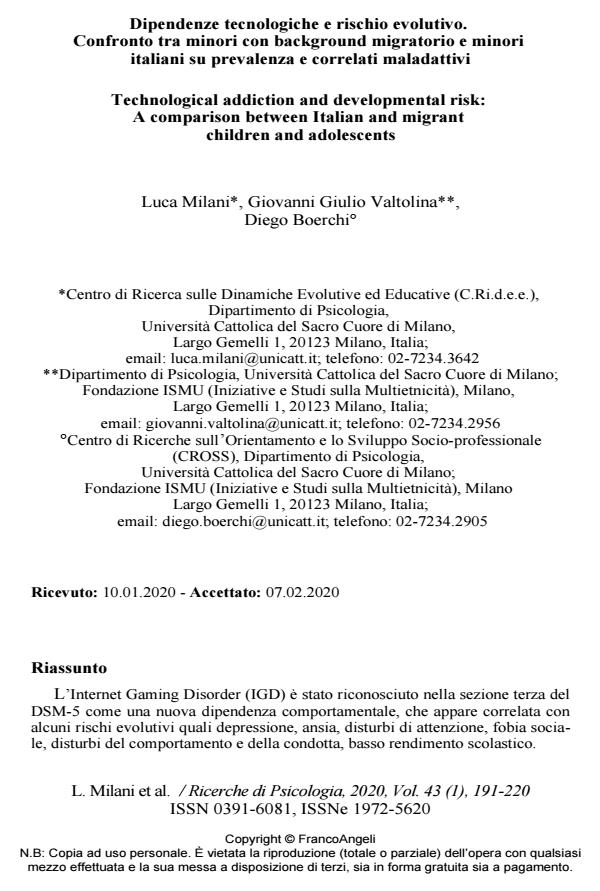Dipendenze tecnologiche e rischio evolutivo. Confronto tra minori con background migratorio e minori italiani su prevalenza e correlati maladattivi
Titolo Rivista RICERCHE DI PSICOLOGIA
Autori/Curatori Luca Milani, Giovanni Giulio Valtolina, Diego Boerchi
Anno di pubblicazione 2020 Fascicolo 2020/1
Lingua Italiano Numero pagine 30 P. 191-220 Dimensione file 286 KB
DOI 10.3280/RIP2020-001009
Il DOI è il codice a barre della proprietà intellettuale: per saperne di più
clicca qui
Qui sotto puoi vedere in anteprima la prima pagina di questo articolo.
Se questo articolo ti interessa, lo puoi acquistare (e scaricare in formato pdf) seguendo le facili indicazioni per acquistare il download credit. Acquista Download Credits per scaricare questo Articolo in formato PDF

FrancoAngeli è membro della Publishers International Linking Association, Inc (PILA)associazione indipendente e non profit per facilitare (attraverso i servizi tecnologici implementati da CrossRef.org) l’accesso degli studiosi ai contenuti digitali nelle pubblicazioni professionali e scientifiche
L’Internet Gaming Disorder (IGD) e stato riconosciuto nella sezione terza del DSM-5 come una nuova dipendenza comportamentale, che appare correlata con alcuni rischi evolutivi quali depressione, ansia, disturbi di attenzione, fobia sociale, disturbi del comportamento e della condotta, basso rendimento scolastico. Di natura affine all’IGD, anche l’Internet Addiction (IA) e stato negli anni studiato come dipendenza comportamentale correlata a un uso incontrollato della Rete con finalita di modulazione dell’umore. L’Internet Addiction e risultata correlata a sua volta con numerosi rischi evolutivi - in parte sovrapponibili a quelli dell’IGD - in chiave internalizzante ed esternalizzante. Considerata la vulnerabilita delle popolazioni migranti alle forme di dipendenza comportamentale come il disturbo da gioco d’azzardo, appare importante verificare se tale vulnerabilita comprenda anche le dipendenze tecnologiche: IGD e IA. Gli obiettivi della presente ricerca sono: 1) ottenere dati di prevalenza di IGD e IA nella popolazione di studenti con background migratorio, 2) evidenziare eventuali differenze in chiave maladattiva correlate alle dipendenze tecnologiche nei minori con background migratorio. 528 studenti (63.6% femmine) con eta variabile tra i 9 e i 20 anni (M = 15.76; DS = 2.176) e frequentanti istituti secondari di primo e secondo grado di quattro citta italiane hanno risposto a una specifica survey sul tema. Il 9.7% degli studenti ha dichiarato di non possedere la cittadinanza italiana. Gli strumenti della survey erano: VGA Questionnaire (VGA) per misurare l’Internet Gaming Addiction; Internet Addiction Test (IAT), per valutare la dipendenza da Internet; Children’s Coping Strategies Checklist-Revised 1 (CCSC-R1) per misurare le strategie di coping in situazioni di difficolta; Test delle Relazioni Interpersonali (TRI) per valutare la qualita delle relazioni sociali in diversi domini. Il 6.1% degli studenti senza cittadinanza italiana soddisfa i criteri diagnostici per l’IGD, contro il 2.0% dei partecipanti italiani, mentre non vi e una differenza statisticamente significativa per quanto riguarda la dipendenza da internet. Il 4.5% dei maschi soddisfa i criteri diagnostici per l’IGD, contro l’1.2% delle femmine, mentre la situazione e opposta per quanto riguarda la dipendenza da internet: 12.2% per le femmine contro l’8.8% dei maschi. I modelli di regressione evidenziano come lo status migratorio, insieme con la tendenza a usare strategie di coping di tipo evitante e distraente, sia un fattore di rischio per lo sviluppo di una dipendenza da videogame. Per quanto riguarda la dipendenza da Internet, al contrario, lo status migratorio non appare un predittore significativo. I risultati di questo studio sembrano indicare una piu alta prevalenza dell’IGD nella popolazione di studenti con cittadinanza non italiana, e confermano come il background migratorio possa essere un potenziale fattore di rischio per lo sviluppo del disturbo.
Parole chiave:Internet addiction, internet gaming disorder, migrazione, rischio evolutivo.
- Migrazioni e psicologie. Introduzione al Forum Alessandro Antonietti, Antonella Marchetti, in RICERCHE DI PSICOLOGIA 1/2020 pp.13
DOI: 10.3280/RIP2020-001002 - Factorial structure of the Internet Gaming Disorder questionnaire in the Italian setting: a single-factored ailment or a multifaceted condition? Luca Milani, Douglas A. Gentile, in European Child & Adolescent Psychiatry /2024 pp.2657
DOI: 10.1007/s00787-023-02322-5
Luca Milani, Giovanni Giulio Valtolina, Diego Boerchi, Dipendenze tecnologiche e rischio evolutivo. Confronto tra minori con background migratorio e minori italiani su prevalenza e correlati maladattivi in "RICERCHE DI PSICOLOGIA " 1/2020, pp 191-220, DOI: 10.3280/RIP2020-001009